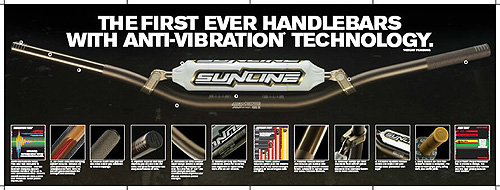







Contact
Us
Archers Company L.L.C.
7527 NE 33rd Dr.,
Portland, OR, 97211
Phone (503) 249-8870
Fax (503) 249-8296
www.archerscompany.com
|
Anti Vibration Handle Bars
View Press Release View HAV information View Test Results Your first question will probably be, “If Sunline just introduced them how is it you’ve been running them for years?” The answer: My business partner and I, Archers Company LLC, invented them – well not the Sunline bar, just the Anti-vibration part. Yep, we are the dyed in the wool flat out T-Edison inventors of the AV part of the Sunline bar. Before I get too far with this explanation let me say first, all the Sunline products, including the bars (with or without the vibration stuff) is absolutely top-of-the-line. Sunline is trying to elbow its way into an established market with a marketing strategy that features product quality, customer service, satisfaction and appreciation. To my estimation, they’re accomplishing this quite handedly and forcing the establish completion play catch-up. History Several years ago my partner and I had an opportunity to work with a major importer of pneumatic tools on vibration dampening systems; more specifically grips. To understand the problems and therefore the solutions to hand and arm vibration we looked at many of the products that were marketed that specifically addressed the issue: baseball bats, golf clubs, chain saws, angle-grinders even motorcycle handle bars. Being a dirt bike rider I was attracted to the handlebars. We discovered that the technology applied to motorcycle bars of the time was borrowed from the sporting goods industry. Without getting overly technical, it was a tube in a tube; the double wall. This technology was grounded in good physics, and probably worked pretty well. However, we also discovered that the double wall bars tended to focus the energy in specific areas of the bar, possibly making them susceptible to fatigue failure. I am not able to back this supposition with any hard evidence and I’m not aware of any of the double wall bars breaking; so no one needs to throw their double-wall in the trash, but the evidence was compelling enough for us to look at other alternatives. There are some other issues with the rigidity of double wall bars, but I’ll explain that later. Armed with nothing more than a good idea, my partner and I discussed ways to possibly market and manufacture anti-vibration handle bars, we even prototyped a few. Like most good ideas though, it took a place on the back shelf while we pursued more profitable business leads; something that would pay the rent for instance. About three years ago my son wanted a new expansion chamber for his motorcycle as a Christmas gift. Searching the internet I found a dealer in California that sold the particular brand wanted. I telephoned and was greeted by a gentleman with, what I thought was an English accent. After a bit of chit-chat I discovered I was talking to the father of a world class motocross rider. I delivered a brief sales pitch regarding anti-vibration handle bars and he agreed to look at them. Down to the local bike shop to buy a set of bars with the correct bend (purchased from D&S Cycle, if anyone’s taking notes). We performed our magic by adding our secret sauce and sent them on to California. I gave it a couple of weeks and telephoned a second time. Turns out the rider liked them and wanted more, which we did. At their request, we even used our process to successfully dampened sub-frames. Their response was quite polite but very frank, we were advised, flat out, patent the anti-vibration stuff and market it, we had a winner. Additionally, this “world class” rider was willing to endorse the product. We became inspired as a result, obtained patent pending status and developed a kit that contained everything needed for the home do-it-yourself er to transform his existing bars into anti-vibration bars. We had what we thought was a finished product. We approached a friend of a friend who worked as a regional sales manager with a major distributor of motorcycle equipment. He also believed we had something useful. He was also nice enough to map out a series of steps he thought we’d need to take to transform our rough prototypes into a marketable product (we didn’t think they were rough). These were good suggestions and useful information, but a bit disappointing. The steps were potentially expensive and time consuming. We kicked back and basically lost interest a second time. About a year later we were contacted by Eddie Cole of Sunline. He found Archers Company through our patent. Eddie expressed an interest in our invention but said he would need something more than just anecdotal evidence, even if the rider who was willing to endorse them was world class. Coincidently this was one of the “steps” that our friend of a friend had given us a year earlier. What is It? We call it Hav-not: HAV represents Hand Arm Vibration and Not for – well, not. The connection should be obvious. The Hav-not is a multi-layered polymer laminate that is both pulled and injected inside the bar to reduce vibration in all three critical areas, frequency, amplitude and duration at the expense of only about 4-ounces of weight. View more info on HAV First ever and exclusive to AVONE ™ handlebars, Archer's internal damping system reduces vibration up to 40% over conventional bars and dissipates vibration faster. View Vibration Test ResultsView View Press Release
|
||
